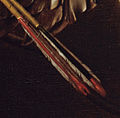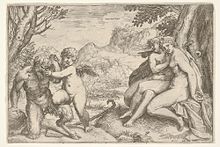Cupid as the winner

|
| Cupid as the winner |
|---|
| Caravaggio , 1602 |
| Oil on canvas |
| 156 × 113 cm |
| State museums in Berlin |
Cupid as a winner is a painting by the Italian baroque painter Caravaggio . The 156 x 113 cm oil painting on canvas was created in 1602 and has been in the Berlin State Museums since 1815 . An alternative Latin title is Amor vincit omnia .
Content and technology
A naked, dark-winged Cupid in the form of a teenage boy sits on a celestial globe that is largely covered by a tablecloth . Right and left, as well as at his feet, lie musical instruments and a music book, compasses and squares, a crown ring, a staff, a purple drapery , a book with a quill pen , a laurel wreath and pieces of armor. In his right hand he holds a bow and two arrows: a red (actually gold) one that evokes love and a black (leaden one) that makes it extinguish. His head is tilted to the left. The pose seems unstable: he rests the toes of his right foot on the floor while he bends his left leg on the waist-high table. The legs are spread so far that even the step is visible. The left hand is turned on its back - the dirty toenails, on the other hand, are a typical realistic detail.
The artist uses bundled light and high-contrast chiaroscuro, making his motif appear particularly vivid. Semi-bright colors such as brown, olive and caput mortuum (violet-tinged red) with connections to red, yellow and blue dominate.
Interpretation and history
The depiction of the victorious Cupid has its origins in the triumph of Eros over Pan . In the traditional interpretation, the name Pan stands for "all", "everything". So love conquers everything, as the alternative title Amor vincit omnia says. The bowstring broke - the weapon served its purpose. The vanquished Pan is represented by the symbols of worldly power, art and science. This makes the message of the omnipotence of love more timeless and easier to understand. Cupid's seat is a celestial globe - so his victory extends beyond the earthly. The provocative nudity, however, is not divine, but remains purely related to the model. This, too, is a reification, just like the objects that replace Pan.
Joachim von Sandrart described the picture in his Teutsche Academie in 1675 . He estimated the age at about twelve years. Sandrart reports that on his advice the picture was covered with green velvet at a painting show and only released at the end, when all the other paintings had been viewed: ... because otherwise all other rarities were made unsightly / so that there was a good chance of an eclipse of all paintings may be named [...]
The Latin title goes back to an eclogue of Virgil : Omnia vincit amor: et nos cedamus Amori. According to the translation Michael von Albrechts : Everything defeats Amor; so we want to obey Cupid! (Eclogen 10.69, Bucolica)
The client was Vincenzo (Marchese) Giustiniani . The picture came to Berlin in 1815 after the Giustiniani collection was dissolved .
Reactions
"Heavenly Cupid" by Giovanni Baglione

In a counterpart by Giovanni Baglione, the "heavenly Cupid", the "earthly Cupid" is caught with a demon. The armed attacker appears like an archangel and holds a red glowing bundle of rays in his right hand. The earthly Cupid holds broken arrows in his left hand and his bow with his right hand. He turns his buttocks towards the viewer and holds the arrows near him. This indicates homosexuality.
Debate in the 21st Century
In the course of the discussion about child pornography triggered by the Edathy affair , the painting came under fire. In an open letter to the Berlin Gemäldegalerie , the portrayal of the boy was condemned as offensive due to the obscenity of the scene and the age of the model, and the demand was made that the image should be deprived of its publicity. Museum director Prof. Bernd Lindemann decidedly rejected the allegations, citing freedom of art and described the claims as absurd. In a comment for the online magazine Telepolis , Bettina Hammer saw the demands again as a logical consequence of the current debate.
See also
- Omnia vincit amor (Latin motto)
Individual evidence
- ↑ a b c d Andreas Prater: Light and Color in Caravaggio. Studies on the aesthetics and iconology of light and dark . Franz Steiner Verlag 1992 ISBN 978-3-515-05441-6 p. 149 ff.
- ^ Sandrart.net: The Teutsche Academie in full text. P. 404 (accessed March 6, 2014)
- ↑ P: Vergilius Maro: Bucolica - Shepherd poems. Stuttgart: Philipp Reclam jun. 2008. Latin / German, translation by Michael von Albrecht p. 89 ISBN 978-3-15-018133-1 . For comparison, the translation by Johann Heinrich Voss : Love sings about the world; let us also give way to love! (Verse 69, Gutenberg project )
- ↑ SMB digital. Online database of collections accessed on March 6, 2014
- ↑ Victoria von Flemming: The victory of boys or of voluntary and involuntary servitude in: Mechthild Fend and Marianne Koos (eds.) Masculinity in view. Visual staging in art since the early modern period , Böhlau Verlag ISBN 978-3-412-07204-9 p. 114
- ↑ Caravaggio's "Amor als Sieger" should be in the depot (Berliner Zeitung article of February 28, 2014). Viewed on March 3, 2014
- ↑ Too provocative for Berlin's moral guardian (comment from Berliner Zeitung of March 3, 2014). Viewed on March 4, 2014
- ↑ Cupid, Cupid, Cupid ... should not be naked and young (Comment from Telepolis magazine of March 5, 2014). Viewed on March 11, 2014



